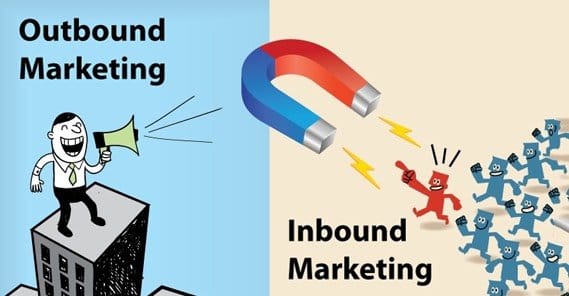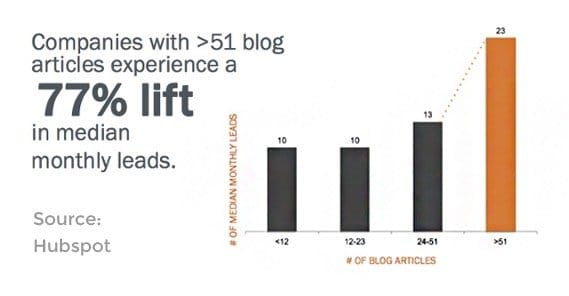The Difference of Inbound vs. Outbound Marketing

All marketing, in general, can be divided into one of two categories. These categories are Inbound and Outbound. What defines each category? Which is better to use? Let’s take a look.
What is Outbound Marketing?
Outbound marketing is also known as interruption marketing, and for a long time it was the primary form of marketing for most businesses. Think of it like this; the business using outbound marketing is going out and trying to find people it can convince to come visit their storefront. It’s aggressive, it’s disruptive, and it’s unsolicited.
Some typical examples of outbound marketing include direct mailers, cold calls and robocalls, TV commercials, radio commercials, and that sort of thing. Spam emails also fall into this category, though email marketing in general can fall on either side of the line.
Essentially, any kind of marketing that gets in your way, interrupts what you’re doing, and is unrelated to what you’re doing is outbound marketing. By some definitions, this can even include pop-up marketing on websites, particularly when the pop-up isn’t related to the site you’re browsing.
Some people refer to this as the “yelling at people” marketing style. That’s because possibly one of the purest versions of the idea is the idea of someone standing on a soap box shouting about their wares to a crowded market.
The number one drawback to outbound marketing techniques is the sheer cost of running a campaign. A direct mailer to an entire neighborhood or an entire city can be incredibly expensive. So can buying advertising space in magazines or newspapers, both of which are on the way out themselves. It’s even worse to buy a TV commercial slot, depending on when you want your ads displayed. Superbowl ads are notorious for their extreme cost, where a 30-second time sow can cost $4.5 million dollars.
The number two drawback is the relatively low-impact nature of these advertising methods. Sure, your ad might be seen by thousands of people, maybe millions if it’s a high-profile TV slot. How many of those people care? A lot of them leave the room during a TV commercial, or mute it, or change the channel temporarily. Of those that stick around, most of them don’t care about your brand or product. Of those that do, a portion of them probably already have it. You’re paying a lot of money to expose your ads to a lot of people who don’t care and don’t have any intention of buying. That’s a lot of wasted money.
44% of all direct mail is never opened, making it a waste of postal service worker time, a waste of postage money, and a waste of paper.
86% of people skip TV commercials in some way or another. This number is higher than ever since the innovation of recorded television allowing commercial skips or skips of 10-30 seconds at a time.
84% of young users, ages 25-34, report having left a website or closed a browser tab because of an irrelevant or intrusive advertisement.
The core point to take away from this is that over the last few decades, information density has increased dramatically. There’s more available incoming information per person than there ever has been in the past, which gives consumers a lot more control over what they intake. That means they’re no longer captive, forced to experience commercials in order to consume their intended media. They can fast-forward or skip or otherwise ignore large quantities of advertising.
This is not to say that all outbound marketing is ineffectual and that you should stop using it or avoid it entirely. To a certain extent, you need to have some outbound marketing if you want to succeed. You need to put yourself in the way of people who don’t know about you, so they can learn about you and come to you for future marketing. As a core marketing strategy, though, it’s just not effective any more.
What is Inbound Marketing?
Everything outbound marketing is, inbound marketing isn’t. While that may seem like a useless definition, it’s kind of true. That’s not all there is to it, though. Inbound marketing is marketing to a captive, interested audience.
What falls under the heading of inbound marketing? Blogs, for one thing, are one of the most common forms. YouTube videos, all forms of SEO, RSS feeds, ebooks, landing pages, highly targeted ads; these are all forms of inbound marketing.
The difference between outbound and inbound is that inbound marketing is a conversation with interested parties. When someone calls your office and is already interested in your product, you pass them off to a salesman, who then makes their pitch and tries to close the deal. That’s inbound marketing; the customer knows about you and came in for the marketing.
Inbound marketing is everything outbound is not. It’s cheaper and it’s more efficient than outbound, by a long shot. Running moderately-targeted Facebook ads can reach as many people as direct mailers with ease, and it’ll cost a lot less to do it. Plus, with a little interest and demographic targeting, you already know these people are at least aware of or interested in your business. Half the work of marketing – building brand awareness – is already done.
The key difference between inbound and outbound is that inbound is also called “permission marketing.” In other words, the users are implicitly giving you permission to market to them. When they sign up for your mailing list, that’s permission. When they follow you on social media, that’s permission. When they express interest in your products over an email or phone call, that’s permission.
This is a stark contrast to outbound marketing’s interruption-based tactic. Interruption irritates users; permission is welcomed. People turn off commercials, throw away direct mailing, and delete spam emails. People welcome newsletters, open special messages, and click on targeted ads.
There are two basic types of inbound marketing, as well. These are active and passive communications.
Active communications are the conversations you have with interested users, followers, and subscribers. They’re messages you send directly to people along communications channels they have given you permission to use. Sending a newsletter to your subscribers is one such method. Another is posting on your social media page about your products. With both, the only people who receive the message are people who asked to receive such messages.
Passive communications are the ways you provide means for people to contact you, or to get value from you without needing to contact you. Ads you proliferate to less-targeted audiences fit this bill, but the most important means is a blog. A blog is what you use to anticipate the questions your users will ask, and to answer those questions before they are asked. This way, when users do ask, they find the answer, and they find you attached to it. This is also where SEO comes in, as optimizing yourself for the search engines is how you get your content found.
The Holistic Nature of Inbound
One of the biggest problems with outbound marketing is disruption and the irritation users feel because of it. There’s a massive press of outbound ads everywhere, and people ignore a lot of them. To gain any attention at all, an ad and company need to stand out. This has led to a lot of different approaches, from the Old Spice wackiness to the GoDaddy sex appeal. The problem is, when you stick out more, you tend to earn more ire as well. The squeaky wheel gets the grease, after all.
With inbound marketing, you don’t have to worry about your volume irritating people and driving them away, because they’re already in your funnel out of their own volition. Sure, you can be seen to spam your newsletter if you’re not careful, but that’s a rarity. Things like your blog don’t have a functional limit. You can post three pieces of content every day and no one is going to accuse you of flooding them.
Inbound marketing is holistic, in that every additional component you add just builds upon the whole. Your blog is a core feature, but your newsletter adds to it. They don’t compete, they reinforce each other. If you add in some PPC ads, that further works to funnel people to your blog and your opt-ins. If you add another form of inbound marketing, it further builds.
A huge part of inbound marketing is the desire to educate. At the end of the day, you’re selling a product, and one of the best ways to sell a product is to convince users they need it. Educating them about their problems and the solution to those problems is one way to do it. Further, by providing educational materials and support, you prove to your potential customers that you’ll be there to help them even after you have their money. This is a big fear with companies in outbound marketing; once they’ve purchased it, that’s it.
By contrast, outbound marketing doesn’t have the luxury of honesty. That’s where fine print comes in, or those TV commercials about medication that have 10 seconds of sped-up voice-over mumbling the side effects and usage directions. That’s all crucial information, but it’s not information that sells, so it’s only included in the minimum way possible so it doesn’t get in the way of the message. The message, in this case, being “buy our stuff, it’s the best stuff, all other stuff is second to our stuff.”
Another difference between inbound and outbound marketing is your control over the channels. With outbound marketing, you’re renting distribution. You’re paying for a limited timeslot, or a one-time mass mailer, or some other temporary form of communications. With inbound marketing, you instead have control over your distribution channels. You might not own Facebook, but you own and control your Facebook page, your Twitter account, and your other social profiles. You might not own the web hosting, but you own the website and blog you host. They aren’t going to disappear on you after a time unless you cancel or stop paying for them.
Confirmation
Perhaps one of the largest differences from the business side of things between inbound and outbound is the concept of measurement. We internet marketers, we’re used to having a wealth of data about every aspect of our marketing. We can see the number of people who see ads, the number of people who click them, the amount of time they spend on our sites, and a whole lot more besides.
When you run a TV commercial, radio ad, or mass mailer, what do you get? If you’re lucky, you can include a specific URL or something for the users to visit, but it’s hardly precise. You never know how many people actually see your ads. You never see how many people even pay attention to your brand name. You don’t have a clue which of the 45 times your commercial ran was the best. There’s no secret Google Analytics for TV. The best you get is asking customers where they heard of you, and hoping they remember well enough to tell you.
With all of the tracking you have through inbound marketing, you can build complete customer portfolios internally. You don’t want to show users just how much you know about them, of course; that leads to fears of privacy compromises and other issues. You can use it internally, though, to show you keep track of them. Some dashboards, for instance, cross-reference information from visitors and opt-ins with social media so one user will have a page that lists their email, their social accounts, and any open communications you have with them. It’s always useful to be able to see “oh, this customer asked us about how to do X on Twitter, but they also asked us via Email.” That cuts down on wasted effort of answering the question twice.
Oh, and one more thing; inbound marketing can be incentivized. It’s difficult to say to someone “hey, we’ll pay you $1 if you watch our TV commercial.” You have no way of verifying that they watched, and you have no way to track who to pay. With inbound marketing you don’t just get the ability to track all of that; you don’t even need to. Landing pages with free ebooks in exchange for an opt-in are bog-standard for inbound marketing. They incentivize an opt-in – and thus permission for inbound marketing – automatically.
There’s a lot of benefit to inbound marketing, not the least of which is how powerful and cheap it is in comparison to outbound. You can even automate a lot of it, safely, without putting your business or your customer relationships at risk.
Outbound marketing has a place, of course. To a certain extent, it still works, and it serves to get people to the initial stages of your inbound marketing. However, it’s still much better to rely more heavily on inbound than outbound.

 ContentPowered.com
ContentPowered.com









